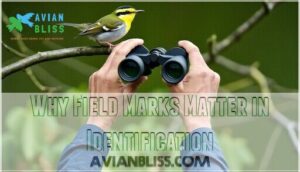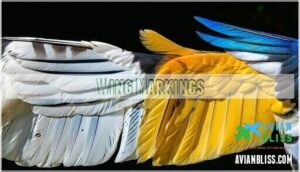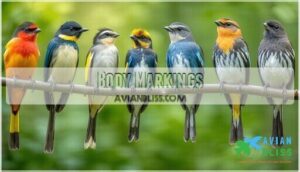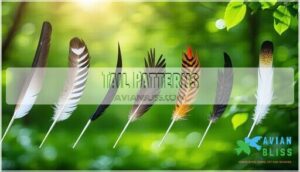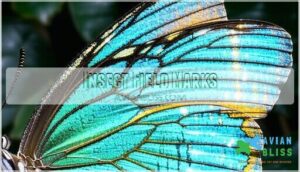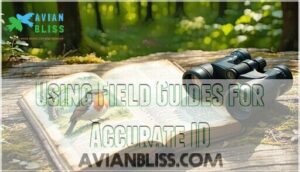This site is supported by our readers. We may earn a commission, at no cost to you, if you purchase through links.

Field marks work for all wildlife: plants have unique leaf shapes, insects show distinctive wing patterns, and mammals display characteristic fur markings. Mastering these features transforms confusing wildlife encounters into confident identifications, whether you’re a beginner naturalist or seasoned researcher tracking species for conservation work.
Table Of Contents
- Key Takeaways
- What Are Field Marks?
- Why Field Marks Matter in Identification
- Key Field Marks in Birds
- Field Marks in Other Wildlife and Plants
- Football Field Marks and Dimensions
- Using Field Guides for Accurate ID
- Advanced Bird Identification Techniques
- Common Challenges in Using Field Marks
- Tips for Mastering Field Mark Identification
- Field Status and On-Site Markings
- Frequently Asked Questions (FAQs)
- What are examples of field marks?
- What are field markings?
- What are the parts of a bird?
- What is the Malar line on a bird?
- Whats the difference between field marks and plumage?
- How do I identify a birds age?
- Are there any free field guides?
- What are some common misidentifications?
- How can I improve my bird ID skills?
- How do juvenile field marks differ from adults?
- Conclusion
Key Takeaways
- You’ll identify birds faster by focusing on distinctive head markings like crown stripes, eyebrow stripes, and malar stripes that create unique patterns separating similar species.
- Wing markings provide reliable identification clues whether birds are perched or flying – look for wing bars, patches, and primary projections that remain visible from different angles.
- Field marks aren’t limited to birds – you can use the same identification principles for plants (leaf shapes, flower structures), insects (wing patterns, body segments), and mammals (distinctive markings, fur patterns).
- You’ll overcome common identification challenges by accounting for lighting conditions, seasonal plumage changes, and molt variations that can alter how field marks appear in different situations.
What Are Field Marks?
Field marks are visible features that help you identify different species in nature, including distinctive patterns, colors, shapes, and anatomical characteristics.
You’ll use these key features to quickly distinguish between similar-looking birds, plants, insects, and other wildlife during your outdoor observations.
Definition of Field Marks
Field marks are nature’s identification cards—specific visual features that help you distinguish one species from another. These identifying features include distinctive patterns, colors, shapes, and anatomical highlights visible on birds, plants, and other wildlife.
Think of them as nature’s fingerprints: each species displays unique combinations of markings that make field identification possible, even from a distance.
History and Usage
The origins of field marks trace back to the late 1600s, when Francis Willughby and John Ray developed the first systematic approach to identifying birds. Their work replaced folklore with scientific observation, laying the foundation for modern field guide identification.
Roger Tory Peterson transformed these early applications in the 1930s by using arrows to highlight key features, making it easier to identify birds in the field.
Understanding the guide’s structure is essential for successful identification.
Disciplines Using Field Marks
Scientists and naturalists use field marks across multiple disciplines for quick species identification in the wild. You’ll find these visual cues essential whether you’re studying birds, plants, or insects during your outdoor adventures.
Here are five key disciplines that rely heavily on field marks:
- Ornithology – Bird identification through wing bars, head patterns, and tail shapes
- Botany – Plant recognition using leaf arrangement, flower structure, and fruit characteristics
- Entomology – Insect classification via wing venation, body coloring, and segmental differences
- Wildlife Biology – Mammal and reptile identification through distinctive markings and features
- Conservation Research – Biodiversity assessments requiring accurate species recognition in field studies. Leg color and length indicate habitat preferences in birds.
Why Field Marks Matter in Identification
You’ll quickly discover that field marks serve as nature’s identification system, allowing you to distinguish between similar species with confidence and precision. These distinctive features become essential tools for accurate wildlife observation, whether you’re tracking migration patterns for research or simply enjoying a peaceful morning of birdwatching in your backyard.
Importance for Birdwatchers
You’ll find field marks become your best friends during Beginner Birding adventures. These visual clues transform confusing flocks into identifiable species through Quick Recognition patterns. Mark Memorization helps you spot differences between similar birds instantly. Your field guide becomes more useful when you understand how field marks enable Species Differentiation.
Bird ID success depends on recognizing these distinctive features that help identify birds efficiently. Expert birders also utilize molting patterns for identification.
Role in Wildlife Observation
Beyond casual birdwatching, field marks serve as the backbone for professional remote observation and data collection. When conducting wildlife surveys, these visual cues let you identify birds from considerable distances without disturbing their natural behaviors. Non-invasive methods rely heavily on your ability to recognize species through distinctive markings, wing patterns, and behavioral field marks. This makes field guides indispensable for accurate documentation that directly aids conservation efforts.
Use in Conservation and Research
Field marks power modern conservation efforts through systematic Data Collection and Species Monitoring. When you identify birds using consistent field marks, researchers can track population trends across different Habitat types. This standardized approach facilitates accurate Habitat Assessment and promotes Conservation Planning initiatives.
Field marks unlock nature’s secrets—turning confused observations into confident species identifications for conservation success.
Your field observations contribute to Impact Studies that measure environmental changes and guide protection strategies for threatened species worldwide.
Key Field Marks in Birds
When you’re trying to identify birds in the field, you’ll need to focus on four main categories of markings that act like nature’s ID cards. These visual clues—found on the head, wings, body, and tail—help you distinguish between similar species and make confident identifications even from a distance.
Head Markings
When you’re studying a bird’s head, focus on the crown stripes, eyebrow stripe (supercilium), and malar stripe (whisker mark) running below the eye. These field marks of the head create distinctive patterns that separate similar species.
Notice if there’s an eyeline cutting through the eye or head crests that stand out. The supercilium above the eye and malar stripes below form reliable identification markers you’ll recognize with practice.
Wing Markings
Moving from head details, wing markings offer some of the most reliable identification clues you’ll encounter in the field. These features remain visible whether birds are perched or soaring overhead, making them incredibly valuable for quick species recognition.
Wing bars appear as distinctive light or dark stripes across folded wings, while primary projections show how far flight feathers extend beyond the wing coverts. Wing patches create bold contrasts during flight, and wing lining reveals the underwing’s coloration pattern.
- Wing shape variations help distinguish between soaring raptors, flapping songbirds, and gliding waterfowl based on their ecological niches
- Alula identification becomes critical when observing birds in flight, as this small feather cluster controls airflow during slow-speed maneuvering
- Wing tips provide species-specific patterns, from pointed swallow wings to rounded robin wings, reflecting each bird’s flight style and habitat preferences
Body Markings
Body markings reveal vital field marks through color pattern variations across the breast, belly, and flanks. You’ll notice sexual dimorphism in many species—males often display brighter plumage than females.
Camouflage patterns help birds blend with their environment, while age indicators show differences between juvenile and adult body parts. Individual variation means no two birds look identical, and artificial markings from banding programs sometimes appear on wild specimens.
Tail Patterns
After examining body markings, you’ll notice tail patterns reveal equally important identification clues. Rectangular tail shapes help songbirds fly fast, while forked tails boost maneuverability in raptors. Color variation and rump contrast create distinct field marks that separate similar species during challenging identifications.
- Tail Shape: Rectangular, forked, graduated, or rounded edges indicate different flight behaviors
- Feather Arrangement: Terminal bands, subterminal markings, and crossbars distinguish species groups
- Color Pattern: White tips, black bands, or rufous undertail coverts provide diagnostic features
- Tail Function: Fanned displays during courtship or tail flicking while foraging reveal behavioral patterns
Field Marks in Other Wildlife and Plants
While birds get most of the attention, plants and other wildlife offer equally distinctive field marks that make identification straightforward once you know what to look for.
From leaf shapes and flower clusters in plants to wing patterns in butterflies and facial markings in mammals, these visual clues work the same way as bird field marks to help you confidently name what you’re observing in nature.
Plant Identification Features
While birds dominate field identification guides, plants offer equally distinct markers for species recognition. You’ll find Leaf Arrangement patterns—alternate, opposite, or whorled—serve as primary field marks. Bark Texture, Stem Characteristics, and Flower Structure provide additional clues.
Size Shape variations in fruit morphology help distinguish similar species. Color patterns in leaves, flowers, and stems create reliable field guide references for accurate plant identification. Examining a plant’s leaf blade structure is also a useful identification method.
Insect Field Marks
When identifying insects, you’ll rely on distinctive field marks like Wing Venation patterns, Body Segmentation, and Antennae Types. Color patterns such as stripes and spots help distinguish species quickly.
Size Shape variations, along with Leg Morphology differences, provide essential identification clues. These body parts create unique combinations that separate similar insects—like spotting a beetle’s elytra markings or recognizing specific Coloration Patterns on butterfly wings.
Mammal and Reptile Markings
While insects reveal themselves through wing patterns, mammals and reptiles offer their own identification secrets. Mammalian pelage displays unique features like guard hair length and color patterns that create effective camouflage patterns.
You’ll spot size shape differences in tracks—canids show claw marks while felids don’t. Reptilian scales provide venomous markings and distinctive banding that warns predators.
These field marks combine behavior and color to facilitate accurate species identification.
Football Field Marks and Dimensions
You’ll find football field markings serve a completely different purpose than wildlife identification, but they’re equally precise in their measurements and placement.
Standard football fields measure 360 feet long by 160 feet wide, with clearly marked yard lines, hash marks, and end zones that help players and officials navigate the game just like field marks help you identify birds in nature.
Field Length and Width
American Football Field dimensions follow strict regulations you’ll find everywhere from high school to the NFL. Each field spans exactly 120 yards long and 53.3 yards wide, covering 1.32 acres.
The Football Field Size remains constant across all levels, ensuring consistent gameplay. The field marks include precise measurements where marking accuracy within 1/4 inch is required for official play standards, including strict regulations and a need for precise measurements.
End Zones and Hash Marks
Each American football field features two 10-yard deep end zones spanning the field’s full 53.3-yard width. Hash marks serve vital purposes in Field Marking Evolution, positioned differently across levels—high school places them 53’4" apart, college 40′ apart, and NFL aligns them 18’6" apart with goalposts.
These Marking Material Science innovations guarantee consistent ball placement, while End Zone History shows how Dimensions Impact Game strategy evolution.
Yard Lines and Goal Lines
You’ll find yard lines marked every 5 yards across the American football field, creating a clear numbering system from each goal line to the 50-yard line. Hash marks serve their purpose by indicating legal snap locations, while measurement accuracy guarantees precise field division. Goal lines define where the playing field meets each end zone, maintaining consistent line placement standards.
Some birds, like quail, prefer grasslands and fields as their habitat, and this is related to the broader concept of field division in different contexts.
Using Field Guides for Accurate ID
Field guides transform field mark identification from guesswork into systematic species recognition through visual keys, range maps, and detailed illustrations.
You’ll master accurate identification by comparing observed features with guide descriptions, understanding standardized symbols, and recognizing natural variations within species, which leads to systematic species recognition.
Matching Key Features
Three key strategies will sharpen your field marks identification skills. Start with feature prominence—focus on the most obvious characteristics like bright wing bars or distinctive head patterns. Use contextual clues from habitat and behavior to narrow possibilities.
For assistance, consider using reliable bird guides. Practice pattern recognition by systematically comparing body parts, eliminating species that don’t match your observed bird shapes and markings.
Understanding Guide Symbols
Field guide symbols serve as your roadmap through the complex world of bird identification, transforming visual clutter into organized information. Understanding these standardized icons helps you navigate Guidebook Layout efficiently, connecting field marks to specific species through careful Iconography Design. These symbols are even used to sell field guide merchandise.
- Size Shape indicators show relative bird proportions using simple geometric forms
- Visual Hierarchy organizes information from most to least distinctive field marks
- Cross-referencing arrows link similar species for quick comparative analysis
- Symbol Evolution reflects updated taxonomic classifications in newer guide editions
- Color coding distinguishes seasonal plumages and gender variations across bird shapes
Accounting for Variation
Beneath every successful bird identification lies an understanding that field marks aren’t static. Age differences create plumage changes, while geographic variation alters familiar patterns. Lighting conditions can mask true colors, and hybridization effects blur species boundaries.
Your field guide shows typical examples, but real birds display size shape variations across populations. Recognizing these natural differences in bird body parts prevents misidentification frustrations during your outdoor adventures. To accurately identify birds, consider using specialized bird guides and understanding plumage changes.
Advanced Bird Identification Techniques
When basic field marks aren’t enough to identify a tricky bird, you’ll need sophisticated techniques that go beyond simple color patterns.
These methods help you distinguish between similar species by focusing on flight behavior, vocalizations, and subtle behavioral cues.
Observing Flight Patterns
When birds take flight, you’ll notice distinct wing shapes and flapping cadence that reveal their identity. Soaring techniques vary dramatically—hawks use thermals while swallows dart with rapid wingbeats.
Gliding styles differ too; gulls glide smoothly while woodpeckers follow undulating patterns. Migration patterns showcase endurance flight behaviors that distinguish species through size, shape, and basic bird body parts working in harmony, including their use of distinct wing shapes.
Analyzing Sounds and Calls
Beyond visual cues, you’ll discover that sounds reveal bird identification mysteries. Each species produces unique frequency patterns and call functions that your field guide can’t capture.
Vocal mimicry complicates identification, while song dialects vary regionally. Acoustic adaptations help birds navigate different soundscapes impact. Listen for throat variations, beak-influenced tones, and size shape correlations in calls.
Behavioral Field Marks
Watching how birds behave reveals as much as their physical field marks. You’ll notice foraging behavior patterns that distinguish species—woodpeckers spiral up trees while nuthatches move headfirst down. Mating displays, social signals, and predator avoidance tactics become reliable identifiers.
Your field guide highlights these behavioral clues alongside basic bird shapes and flight patterns for complete identification.
Common Challenges in Using Field Marks
You’ll face three main obstacles when using field marks: similar-looking species that share key features, changing light conditions that alter color appearance, and seasonal variations like molting that transform a bird’s markings.
These challenges can turn confident identifications into guesswork, but recognizing these pitfalls helps you become a more accurate observer.
Similar Species Confusion
Many similar species share nearly identical field marks, creating identification puzzles that’ll test your skills. You’ll encounter look-alikes that differ by subtle details—like eyering thickness or wingbar positioning. Your field guide becomes invaluable when distinguishing these tricky pairs:
- Compare size and shape proportions carefully
- Note geographic variation within species ranges
- Watch for age-related changes in plumage patterns
- Study hybrid identification challenges in overlap zones
Effects of Lighting and Distance
Poor lighting and viewing distance dramatically affect your ability to spot field marks accurately. Shadow distortion can hide an eyering, while glare impact washes out vital color perception details.
Distance haze makes size and shape assessment challenging, and varying light angles alter how field marks of the head appear in your field guide comparisons.
Seasonal and Molt Variations
When do seasonal plumage changes throw you off track? Birds undergo dramatic transformations throughout the year, making field marks unreliable during molt timing and breeding seasons.
- Breeding plumage creates vivid colors in spring that fade to dull winter tones
- Eclipse plumage in waterfowl produces confusing intermediate appearances during molt
- Age variation means juveniles display muted field marks compared to adults
- Molt timing creates patchy, uneven feather patterns that obscure key identifying features
- Size shape of beak and wings may appear different when feathers are missing or growing
Tips for Mastering Field Mark Identification
Mastering field mark identification takes consistent practice and the right approach to build your skills effectively. You’ll accelerate your learning by combining hands-on field experience with modern tools and expert guidance to develop accurate identification abilities.
Practice and Journaling
Regular practice sharpens your field mark recognition skills dramatically. Keep detailed Field Notes documenting each sighting, including Size Shape observations and specific Field Marks of the wing patterns. Sketching Techniques improve memory recall better than photos alone. Focus on bird anatomy details like beak shape and proportions during consistent practice sessions.
| Practice Method | Journaling Benefits | Weekly Goal |
|---|---|---|
| Daily sketches | Improves visual memory | 5 species |
| Field Notes | Tracks progress patterns | 10 entries |
| Anatomy focus | Builds identification speed | 3 features |
Leveraging Technology
Apps and AI transform field mark identification through instant image recognition and digital field guides. You’ll capture photos for automated species suggestions, access vast databases offline, and contribute to citizen science projects.
Modern apps analyze bird anatomy features like beak shape, wings, and size automatically, making identification faster and more accurate than traditional methods.
Learning From Experts
Experienced birders’ insights accelerate your field mark mastery substantially. Join local Audubon chapters or birding groups where seasoned naturalists share expert credentials and collaborative learning opportunities. These mentors help you distinguish subtle differences like eyebrow stripes versus malar stripes, or identify throat patches and crown stripes accurately.
Mentorship benefits include avoiding misinformation while developing confidence in field mark recognition through guided practice sessions.
Field Status and On-Site Markings
When you’re out in the field studying wildlife, you’ll need to understand more than just bird field marks—you’ll also encounter actual field closure signs that determine where you can and can’t observe. These on-site markings from park authorities take priority over any online information, so always check posted signs before setting up your birding equipment or entering athletic fields used for wildlife observation.
Interpreting Field Closure Signs
Understanding field closure signs isn’t just about reading words—it’s about recognizing the Sign Authority behind each posted notice. These signs override rules that might otherwise allow field access, clearly stating closure reasons like wet conditions or maintenance schedules.
Look for these five key elements when interpreting closure signs:
- Bold "Fields Closed" text with prohibition symbols
- Specific timeframes indicating closure duration
- Reason statements explaining wet weather or maintenance
- Authority identification showing who posted the notice
- Contact information for status updates or questions
Sign placement occurs at main entrances and high-visibility areas. Your user responsibility includes checking signs before play, just as you’d examine field marks like size, shape, beak, wings, and tail banding when identifying birds. Both require careful observation skills.
Birds use aggressive vocalizations to defend their territory.
Adhering to Park Authority Rules
When field closures occur, you’ll need to respect park authority rules without question. Field closure signs always take precedence over online postings and hotline usage information, even when websites show open status. This sign precedence protects both you and the field itself.
| Rule Category | What You Must Do | Consequence |
|---|---|---|
| Sign precedence | Obey closure signs over online info | Access denied |
| Hotline usage | Call 703-324-5264 for updates | Current status |
| Permitting process | Secure proper field permits | Legal compliance |
| Rule enforcement | Follow all posted regulations | Potential fines |
| Field marks | Note boundary and safety markers | Safe play area |
Remember, rule enforcement isn’t just bureaucracy—it’s about maintaining quality playing surfaces and safety standards for everyone.
Frequently Asked Questions (FAQs)
What are examples of field marks?
Spotting wildlife becomes incredibly easier when you recognize key identifying features! Look for wing bars, eye-rings, belly bands, tail patterns, and distinctive colors that help distinguish one species from another in the field.
What are field markings?
You’ll recognize field markings as distinctive visual features that help identify different species in nature. These include specific patterns, colors, shapes, and anatomical characteristics visible on birds, insects, and plants during outdoor observation.
What are the parts of a bird?
Birds possess countless fascinating parts! You’ll find a head with eyes, beak, and sometimes a crest, plus wings, tail feathers, legs with talons, and a sleek body covered in colorful plumage.
What is the Malar line on a bird?
The malar line (also called malar stripe) is a stripe that runs from the beak down across the bird’s cheek or jaw.
You’ll spot this distinctive marking separating the throat from the cheek region.
Whats the difference between field marks and plumage?
Plumage refers specifically to a bird’s feathers and their colors, while field marks include all visible identifying features like bill shape, leg color, eye rings, and behavioral traits beyond just feather patterns.
How do I identify a birds age?
You’ll look for specific clues like bill color, eye color, and feather patterns. Young birds often have duller plumage, darker eyes, and softer bill coloration than adults.
Are there any free field guides?
Yes, you’ll find excellent free options. The Audubon Bird Guide is completely free and covers over 800 North American bird species. Merlin Bird ID from Cornell Lab offers instant identification with sound recognition features.
What are some common misidentifications?
You’ll confuse hawks with vultures, sparrows with finches, and warblers with vireos. Young birds lack adult markings, seasonal plumage changes throw you off, and similar species share habitats.
How can I improve my bird ID skills?
Like Rome wasn’t built in a day, mastering bird identification takes consistent practice. Focus on one field mark at a time—size, shape, behavior, habitat.
Use apps, join birding groups, and keep detailed notes of your observations. **Keep detailed notes of your observations.
How do juvenile field marks differ from adults?
Juvenile birds usually show duller colors, streaky patterns, and less defined markings than adults. You’ll notice softer edges, brownish tones, and incomplete adult features that develop through molting seasons.
Conclusion
Practice makes perfect when mastering field marks for wildlife identification. You’ve learned that these distinctive features—from wing bars to leaf shapes—serve as nature’s fingerprints. Whether you’re spotting a cardinal’s red crest or identifying tree species, consistent observation sharpens your skills.
Remember that lighting, distance, and seasonal changes affect visibility, so patience is key. Start with common species in your area, keep a field journal, and don’t hesitate to use apps for confirmation.
With time and practice, recognizing field marks becomes second nature, transforming every outdoor adventure into an exciting identification opportunity.
- https://www.thegamebeforethemoney.com/a-brief-history-of-hash-marks/
- https://www.chiefs.com/
- https://onlinelibrary.wiley.com/doi/full/10.1002/9780470015902.a0003096
- https://americanornithology.org/field-guides-2/
- https://www.birdobserver.org/Issues/2015/October-2015/birdwatching-observation-based-field-ornithology-and-the-conservation-movement

